
Cecil Louis Troughton Smith, known by his pen name Cecil Scott "C. S." Forester, was an English novelist known for writing tales of naval warfare, such as the 12-book Horatio Hornblower series depicting a Royal Navy officer during the Napoleonic wars. The Hornblower novels A Ship of the Line and Flying Colours were jointly awarded the James Tait Black Memorial Prize for fiction in 1938. His other works include The African Queen and The Good Shepherd.
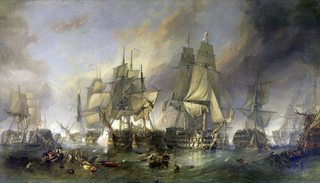
The Battle of Trafalgar was a naval engagement between the British Royal Navy and the combined fleets of the French and Spanish Navies during the War of the Third Coalition of the Napoleonic Wars (1803–1815).
Horatio Hornblower, a fictional officer in the British Royal Navy during the Napoleonic Wars, is the protagonist of a series of novels and stories by C. S. Forester. He later became the subject of films, radio and television programmes, and C. Northcote Parkinson elaborated a "biography" of him, The True Story of Horatio Hornblower.
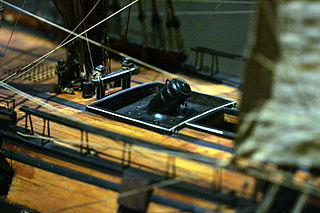
A bomb vessel, bomb ship, bomb ketch, or simply bomb was a type of wooden sailing naval ship. Its primary armament was not cannons – although bomb vessels carried a few cannons for self-defence – but mortars mounted forward near the bow and elevated to a high angle, and projecting their fire in a ballistic arc. Explosive shells or carcasses were employed rather than solid shot. Bomb vessels were specialized ships designed for bombarding fixed positions on land. In the 20th century, this naval gunfire support role was carried out by the most similar purpose-built World War I- and II-era monitors, but also battleships, cruisers, and destroyers.
Dudley Bernard Egerton Pope was a British writer of both nautical fiction and history, most notable for his Lord Ramage series of historical novels. Greatly inspired by C.S. Forester, Pope was one of the most successful authors to explore the genre of nautical fiction, often compared to Patrick O'Brian.

Captain Horatio Hornblower is a 1951 British naval swashbuckling war film in Technicolor from Warner Bros., produced by Gerry Mitchell, directed by Raoul Walsh, that stars Gregory Peck, Virginia Mayo, Robert Beatty and Terence Morgan.
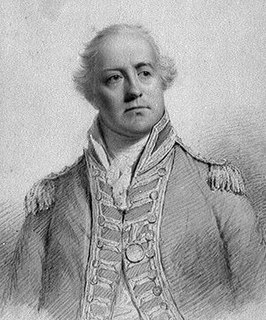
Admiral of the Fleet James Gambier, 1st Baron Gambier, was a Royal Navy officer. After seeing action at the capture of Charleston during the American Revolutionary War, he saw action again, as captain of the third-rate HMS Defence, at the battle of the Glorious First of June in 1794, during the French Revolutionary Wars, gaining the distinction of commanding the first ship to break through the enemy line.
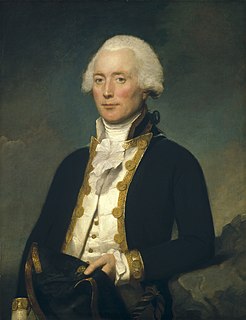
Admiral Sir Robert Calder, 1st Baronet, was a British naval officer who served in the Seven Years' War, the American Revolutionary War, the French Revolutionary Wars and the Napoleonic Wars.

Hornblower and the Crisis is a 1967 historical novel by C. S. Forester. It forms part of the Horatio Hornblower series, and as a result of Forester's death in 1966, it was left unfinished. There is a one-page summary of the last several chapters of the book found on the final page, taken from notes left behind from the author. It was the eleventh and last book of the series to be published, but it is fourth in chronological sequence.

Hornblower and the Atropos is a 1953 historical novel by C.S. Forester.
The Frogs and the Lobsters is an episode of the television program Hornblower. It is set during the French Revolutionary Wars and very loosely based on the chapter of the same name in C.S. Forester's 1950 novel Mr. Midshipman Hornblower and on the actual ill-fated Quiberon expedition of 1795.

Ramage (1965) is the first novel in the Lord Ramage novels by Dudley Pope. It is set during the French Revolutionary Wars and later in the series during the Napoleonic wars.

Admiral Sir Benjamin Hallowell Carew was a senior officer in the Royal Navy. He was one of the select group of officers, referred to by Lord Nelson as his "Band of Brothers", who served with him at the Battle of the Nile.

Horatio Nelson, 1st Viscount Nelson, 1st Duke of Bronté, was one of the leading British flag officers in the Royal Navy of the French Revolutionary and Napoleonic Wars, responsible for several important victories over the French and Spanish navies during a time of crisis for the country. He was widely lauded for his success, and praised for his skill and daring. After his death during the Battle of Trafalgar, he became revered as a British hero, and his fame reached new heights. Large numbers of monuments and memorials have been created in his honour, and he has continued to influence British culture and society.

Vice-Admiral Sir George Murray KCB was an officer in the Royal Navy who saw service in a wide range of theatres and campaigns. His active naval career spanned the American War of Independence and the French Revolutionary and Napoleonic Wars. Murray served under many of the most notable commanders of his age and participated in several of their greatest victories. He was with Parker and Howe in the West Indies and North America, Johnstone and Hughes in the East Indies, Jervis at Cape St Vincent, Nelson at Copenhagen, and took part in a host of other actions and engagements. Temporarily a captive of the French he was a keen scholar and spent time learning the French language and their naval customs, as well as being a competent surveyor, experience that was to help him in later life. He had a particularly enduring friendship with Nelson, who personally requested his services as his captain of the fleet. It was only chance that prevented Murray from serving as such at Trafalgar. With Murray absent, Nelson declined to appoint a replacement, one biographer reasoning that "none but Murray would do".

Sir Robert Brice Kingsmill, 1st Baronet was an officer of the Royal Navy who served during the Seven Years' War, the American War of Independence and the French Revolutionary and Napoleonic Wars in a career that spanned nearly 60 years. Kingsmill was a contemporary and close friend of Lord Nelson, and was one of the prominent Royal Navy admirals of his time referred to as "The Conquerors of the Seas," illustrated in Piercy Roberts' 1800 engraving. He served with Rodney in the West Indies, where he was wounded in battle, and with Keppel at the Battle of Ushant. He took the time to embark on a career in politics as a Member of Parliament, giving this up several times to resume his service in the Navy when war broke out. Kingsmill rose to flag rank by the time of the outbreak of war with revolutionary France in 1793. As the naval commander-in-chief on the coast of Ireland, he repelled several attempts by the French to invade Ireland and foment insurrection. Kingsmill died on 23 November 1805 at Sydmonton Court as a baronet and with the rank of Admiral of the Blue.
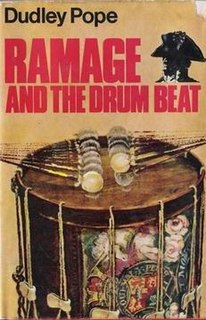
Ramage and the drum beat, later republished as Ramage and the drumbeat and as Drumbeat is an historical novel by Dudley Pope, set during 1796 and 1797 amongst the naval warfare of the French Revolutionary Wars. It is the second of the Ramage novels, following on from Ramage. During the book, Ramage becomes an integral part of ensuring British readiness for the Battle of Cape St. Vincent (1797).
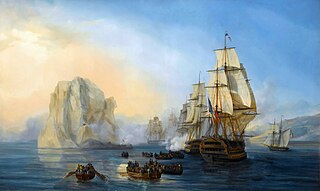
The Battle of Diamond Rock took place between 31 May and 2 June 1805 during the Napoleonic Wars. It was an attempt by Franco-Spanish force dispatched under Captain Julien Cosmao to retake Diamond Rock, at the entrance to the bay leading to Fort-de-France, from the British forces that had occupied it over a year before.

Ramage and the Freebooters, is an historical novel by Dudley Pope, set during the French Revolutionary Wars. It is the third of the Ramage novels, following on from Ramage and the Drumbeat.
William Lechmere was an officer of the Royal Navy who served during the American War of Independence and the French Revolutionary and Napoleonic Wars.















